‘MARKED’ is an exhibition featuring highlights from the publication ‘Marker: 10 Years of the Town Hall Gallery Collection’. Recognising a moment in time for the City of Boroondara’s foremost repository of contemporary art, ‘Marker’ contemplated what artworks and cultural materials had come before and what might come after.
Celebrating 10 years since the publication and 20 years of the Town Hall Gallery, ‘MARKED’ presents seminal works from the publication. Featuring some of the most prestigious and influential pieces in the Town Hall Gallery Collection, this exhibition illustrates the storytelling potential of public collections.
‘MARKED’ captures the notion that an art collection is an ever-evolving narrative of society, capturing ideas and moments in time.
‘An art collection is not just a room of old works in big gilded frames. It is an ever evolving narrative of society, capturing ideas and moments in time. Our collection reminds our viewers of where we have come from and inspired us for what is ahead. It is a compilation of numerous markers of time. The Town Hall Gallery Collection is not only a collection that is based in the visual arts world but is primarily for the people of the City of Boroondara. It is in many ways, their collection.’
Mardi Nowak, Excerpt from ‘Marker’ (2013)
Image credit: Selina Ou, ‘The Postman’, 2003, c type photograph, 100 x 100 cm, Town Hall Gallery Collection.

Selina Ou’s photographs are social snapshots of a particular time in Australian contemporary culture. Embodied with a documentary aesthetic, this work is one of three in the Town Hall Gallery Collection that belong to a series titled ‘Work’ that surveys our relationship to community defined roles, such as a postman, pilot, and policeman.
The role of the individual is attached to the role they perform. In other works, the subtext of the images is ‘are we more than what we do?’ The direct gaze and neutral expressions of each subject is unnerving and it’s as if we have interrupted their workday.
Excerpt from ‘Marker’ (2013)
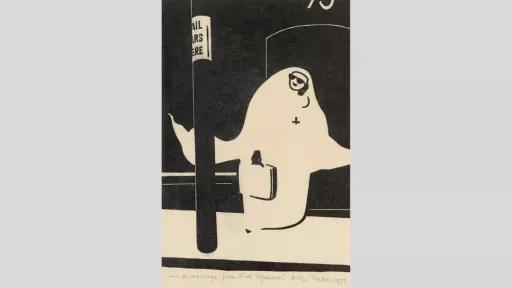
A prolific illustrator, Thake’s simple designs, often monochromatic, offered a stylistic interpretation of Australian life. Filled with humour and wit, Thake is perhaps best known for his yearly Christmas cards, sent out to friends and colleagues.
Australian culture was changing rapidly in the 1970’s and this can be seen in ‘A Message from Our Sponsor’. A nun in her habit with sunglasses and attaché case is listening to a transistor radio. Thake commented that ‘she is receiving enlightenment via the radio.’
Excerpt from ‘Marker’ (2013)
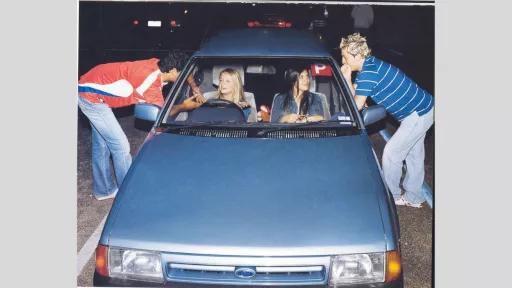
Sleeth captured the ‘Rosebud’ series when visiting Rosebud on the Mornington Peninsula from 2002–2006, usually during the first week of January when the popularity of the foreshore was at its peak. Shot on a medium format camera, the photographs provide a rich documentation of a quintessential Australian experience: summer holidays. This series is comprised of 15 images.
‘Untitled #25 from Rosebud’ presents a stereotypical suburban scene. Two boys are leaning through the window of a small blue car to speak to two girls. They are in the car park of the Rye carnival on New Year’s Eve in 2003. Sleeth accesses a moment that is seemingly banal yet represents a particular Australian subculture of teenagers. Sleeth documented a way of being that was very much ‘of the time’ in the early 2000’s.
Excerpt from ‘Marker’ (2013)

Iconic is a word that is synonymous with the artist John Brack. Much more than just a painter, his artistic practice was diverse yet extremely focused. Unlike other Brack works in the collection, ‘Girl and Mat’ possesses a very different colour palette. Brack references the awkwardness of adolescence, on the uncertainty and promise of that difficult time in life. The blank mat engulfs the foreground of the image, whilst the wooden floorboards act as a metaphor: life goes on and will continue to do so - this too shall pass.
Excerpt from ‘Marker’ (2013)

‘The Ball’ focuses on the humble green tennis ball. Adorning a pared-down background, the ball floats in mid-air, perhaps flying through the air from the far right of the painting. This stylistic portrayal of such an iconic object is a testament to our fascination with sport and leisure in Australia.
Excerpt from ‘Marker’ (2013)
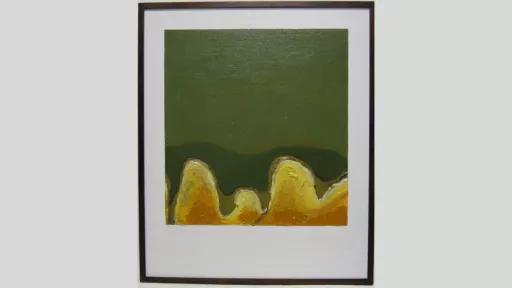
Nina Sers is the quintessential contemporary artist: her multifaceted art practice delves into themes of time, memory, and nostalgia. She invites viewers to indulge in abstract forms as a way to challenge the function of time-based media.
From a series created in 2005, ‘Timed Perfectly’ is a small-scale abstract painting based on altered Polaroid photographs. Sers manipulated the chemicals and emulsion on the surface of a set of Polaroids and the resulting images emerged as landscapes. Framed like their photographic originals, these polaroid-scapes are intimate snapshots that represent an inner-landscape of memory.
Excerpt from ‘Marker’ (2013)
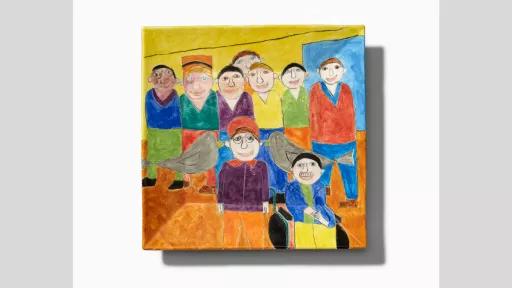
John Bates utilizes his art making practice to express his ideas and observations of the world. His paintings are pulsing with order and harmony. The intricate designs of his paintings use multiple figures, bricks, or buildings to create dizzying patterns. ‘The Art Room’ is a hand painted platter that depicts the artists in the Art Studio at Network Q, a not-for-profit organisation providing vocational training to people with disabilities. Bates commenced work at Network Q in 1990, and has produced many beautiful art works since.
Excerpt from ‘Marker’ (2013)
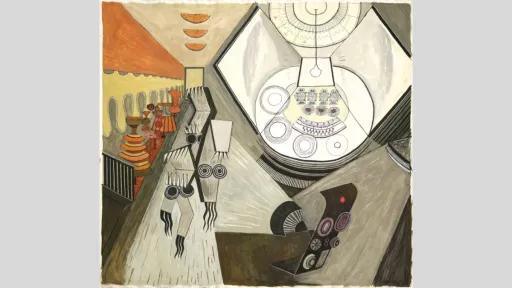
Helen Maudsley imbues her art works with the language of painting and a personalised vocabulary of symbolic images. Referencing the history of Art and mythology, Maudsley draws on her own domestic and social environment for contextual grounding.
Excerpt from ‘Marker’ (2013)